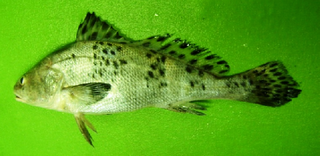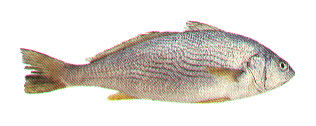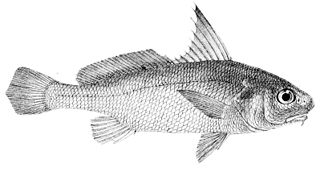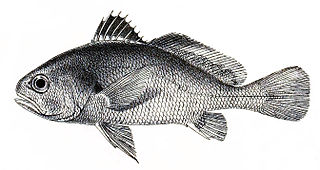
Sciaenidae is a family of ray-finned fishes belonging to the order Acanthuriformes. They are commonly called drums or croakers in reference to the repetitive throbbing or drumming sounds they make. The family consists of about 293 to 298 species in about 66 or 67 genera.

Argyrosomus is a genus of marine ray-finned fishes belonging to the family Sciaenidae, the drums. The fish in this genus are large and are commonly targeted as game fish.
Bahaba is a genus of marine ray-finned fishes belonging to the family Sciaenidae, the drums and croakers. These fishes are found in the Indo-West Pacific region.

Cynoscion is a genus of marine ray-finned fishes belonging to the family, Sciaenidae, the drums and croakers. These fishes are found off the coasts of North and South America in the western Atlantic and eastern Pacific Oceans. Many fishes in this genus have been given the common name weakfish.

Larimichthys is a genus of marine ray-finned fishes belonging to the family Sciaenidae, the drums and croakers. These fishes, commonly known as yellow croakers, are found in the Western Pacific Ocean.

Panna is a genus of marine ray-finned fish belonging to the family Sciaenidae, the drums and croakers. These fishes are found in southern and southeast Asia.

The blackspotted croaker, also known in Australia as the black jewfish, is a species of marine ray-finned fish belonging to the family Sciaenidae, the drums and croakers. This fish is found in the Indo-Pacific region. It is the only species in the monospecific genus Protonibea.

Otolithes ruber, commonly known as the tigertooth croaker, silver teraglin, wiretooth, snapper kob, snapper salmon, Yankee whiting or Yankee salmon is a species of marine ray-finned fish belonging to the family Sciaenidae, the drums and croakers. This species is found in the Indo-Pacific region.

Reeve's croaker, also known as the goldbelly croaker, golden corvina, yellowfin croaker or yellowfin corvina, is a species of marine ray-finned fish belonging to the family Sciaenidae, the drums and croakers. This species is found in the coastal waters of the Indo-Pacific region. It is the only species in the monospecific genus Chrysochir.

Umbrina is a genus of fish from the croaker family Sciaenidae. The genus contains 17 species occurring in tropical and warm temperate waters of the Atlantic, the Mediterranean, the Western Indian Ocean and the eastern Pacific.

Johnius is a genus of marine ray-finned fishes belonging to the family Sciaenidae, the drums and croakers. They are commonly known as croakers due to their ability to produce purring, croaking and knocking sounds. The sounds are produced mainly at night and are thought to be either involved in defense or for courtship.

Atrobucca is a genus of marine ray-finned fishes belonging to the family Sciaenidae, the drums and croakers. These fishes are found in the Indo-West Pacific region.
The yellowtail croaker, also known as the yellowtail jewfish, is a species of marine ray-finned fish belonging to the family Sciaenidae, the drums and croakers. This species is found in the southwestern Pacific Ocean off northern Australia and southern New Guinea. It is the only species in the monospecific genus Austronibea.

Johnius dussumieri, the sin croaker, Dussumier's croaker, Dussumier's silver jewfish, sharptooth hammer croaker or whiskered croaker, is a marine ray-finned fish belonging to the family Sciaenidae, the drums and croakers. This fish is found in the Indian Ocean.

Johnius carutta, the karut croaker or purple jewfish, is a species of marine ray-finned fish belonging to the family Sciaenidae, the drums and croakers. This species is found in the western Indian Ocean.

The kathala croaker is a species of marine ray-finned fish belonging to the family Sciaenidae, the drums and croakers. This species is found in the Indian Ocean off South Asia. It is the only species in the monospecific genus Kathala.

The cuja bola is a species of marine ray-finned fish belonging to the family Sciaenidae, the drums and croakers. This fish is found in the northern Indian Ocean in India, Bangladesh, Myanmar and Thailand. It is the only species in the monospecific genus Macrospinosa.

Otolithes is a small genus of marine ray-finned fishes belonging to the family Sciaenidae, the drums and croakers. The three recognised species in the genus are found in the Indo-West Pacific region.

The half-mourning croaker is a species of marine ray-finned fish belonging to the family Sciaenidae, the drums and croakers. It is the only species in the monospecific genus Paranibea. This fish is found in the Indo-Pacific region.

Pennahia is a genus of marine ray-finned fishes belonging to the family Sciaenidae, the drums and croakers. The fishes in this genus are found in the Indo-West Pacific region.

















